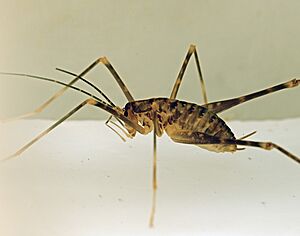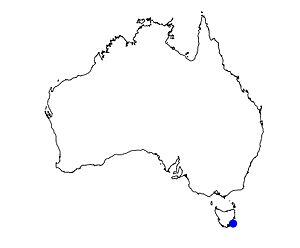Tasmanoplectron isolatum facts for kids
Quick facts for kids Tasmanoplectron isolatum |
|
|---|---|
 |
|
| Conservation status | |
| Scientific classification | |
| Kingdom: | |
| Phylum: | |
| Class: | |
| Order: | |
| Family: |
Rhaphidophoridae
|
| Subfamily: |
Macropathinae
|
| Genus: |
Tasmanoplectron
Richards, 1971
|
| Species: |
T. isolatum
|
| Binomial name | |
| Tasmanoplectron isolatum Richards, 1971
|
|
 |
|
| Observations of Tasmanoplectron isolatum from iNaturalist (as of August, 2023). | |
The Tasmanoplectron isolatum is a special kind of cave cricket. It is a rare insect that is active mostly at night, which means it is nocturnal. This cricket is the only species in its group, called a genus, named Tasmanoplectron. It belongs to the family of insects known as Rhaphidophoridae.
A scientist named Aola M. Richards first described this unique cricket in 1971. It lives only in Tasmania, Australia. Scientists think this genus might be related to animals found in New Zealand. This is because it looks quite different from other cave crickets in Australia.
Where It Lives
The Tasmanoplectron isolatum cricket is found only on Tasman Island. This island is located off the southeast coast of Tasmania, Australia. This small insect has very long legs. It likes to hide in safe places like small spaces between rocks. It also lives inside burrows made by birds. On Tasman Island, people have found these crickets in forests with she-oak trees. They have also been seen in old drains inside buildings.
What It Looks Like
The Tasmanoplectron isolatum cricket is mostly brown. However, its ovipositor, which is a part used for laying eggs, is a light reddish-brown color. Its whole body is covered in thick, tiny hairs called setae.
These crickets are about 18 to 21 millimeters long. Male crickets are usually a little bigger than the females. They have very long, thin antennae. Their legs are also long and slender. Their front and middle legs are about the same length. They are about 2.5 times longer than the cricket's body! The back legs are even longer, about 3.8 times the length of its body.
How It Is Grouped (Taxonomy)
Scientists believe that Tasmanoplectron isolatum is more closely related to at least nine other genera of crickets found in New Zealand and nearby subantarctic islands. This is because they have similar spines on their legs.
However, Tasmanoplectron isolatum has four special features that make it unique. These features are why it is the only member of its genus, Tasmanoplectron:
- The second part of its back leg's foot (called the tarsus) has very few or no spines at its tip.
- The lower parts of the female's ovipositor have a row of spines at the end.
- The male's pseudosternite (a part of its body) is unusually long.
- The male's abdominal styli (small finger-like parts) are located at the bottom and end of its genital plate.



